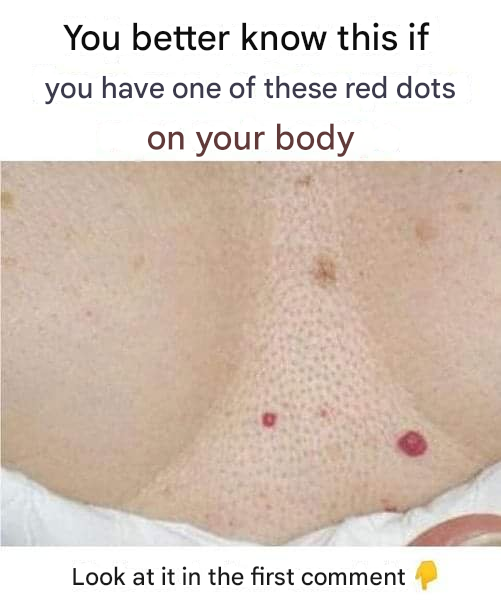IF YOU HAVE THESE RED DOTS ON DIFFERENT PARTS OF THE BODY? HERE’S WHAT YOU NEED TO KNOW ABOUT IT
Red dots appearing on the skin can be concerning, especially when they seem to appear without warning. These dots, which may vary in size, can show up on different parts of the body, from the face to the legs or arms. While they might be harmless in some cases, they can also be a sign of an underlying health condition that requires attention.
1. Petechiae: What Are They?
Petechiae are small, flat red or purple dots that appear on the skin when small blood vessels (capillaries) underneath the skin break. They are typically caused by a minor injury, but they can also result from certain medical conditions such as blood disorders, infections, or even vitamin deficiencies.
Common Causes:
- Injury or Strain: Straining too hard during physical activities, such as lifting heavy objects or even intense coughing or vomiting, can cause capillaries to rupture.
- Medications: Certain medications, like blood thinners or steroids, can make it easier for capillaries to break and lead to petechiae.
- Infections: Infections like septicemia, viral infections, or strep throat can cause petechiae as a symptom of inflammation or infection in the blood vessels.
- Vitamin Deficiency: A lack of vitamin C (scurvy) or vitamin K can cause bleeding under the skin.
2. Purpura: Larger Red or Purple Spots
Purpura refers to larger spots of bleeding under the skin that look similar to bruises. Unlike petechiae, purpura can be several millimeters in size. They may also be caused by capillary breakage, but the underlying causes can be different.
Common Causes:
- Blood Disorders: Conditions like thrombocytopenia (low platelet count), clotting disorders, or vasculitis (inflammation of the blood vessels) can cause purpura.
- Infections: Certain viral infections, such as the human herpesvirus, can cause purpura along with other symptoms like fever or rash.
- Medications: Similar to petechiae, medications that affect blood clotting can lead to purpura.
3. Cherry Angiomas: Harmless Red Dots
Cherry angiomas are benign (non-cancerous) growths of small blood vessels that appear as smooth, red or purple dots on the skin. They are common in adults, especially as they age, and are not generally associated with any health risks.
Common Causes:
- Age: Cherry angiomas become more common as people get older, with the highest incidence in individuals over the age of 30.
- Genetics: A family history of cherry angiomas may increase the likelihood of developing them.
- Hormonal Changes: Hormonal changes, especially during pregnancy, can contribute to the development of cherry angiomas.
4. Heat Rash: When Your Skin Gets Too Hot
Heat rash, also known as prickly heat or miliaria, appears as small red or pink dots and is often accompanied by itching or discomfort. It occurs when sweat becomes trapped in blocked sweat glands, usually during hot weather or physical activity.
Common Causes:
- Hot and Humid Conditions: Exposure to extreme heat or humidity can lead to clogged sweat glands, causing red bumps or dots to appear.
- Excessive Sweating: Overheating due to vigorous exercise or wearing tight clothing that traps sweat can contribute to the development of heat rash.
5. Allergic Reactions: When Your Skin Reacts
Red dots may also appear as part of an allergic reaction. When the skin is exposed to allergens, the immune system responds by releasing histamines, which can lead to red spots or rashes.
Common Causes:
- Food Allergies: Certain foods, such as nuts, seafood, or dairy, may trigger an allergic reaction that causes red spots to appear on the skin.
- Pollen or Dust: Seasonal allergies can also cause red dots or hives on the skin.
- Skin Care Products: Sometimes, lotions, soaps, or fragrances can irritate the skin and cause redness or red spots.
6. When to See a Doctor
While most of the causes for red dots on the skin are harmless, it’s important to seek medical advice if you experience any of the following:
- The red spots don’t fade when you press on them (a sign that they may not be petechiae).
- You experience additional symptoms, such as fever, weakness, or difficulty breathing.
- The spots are increasing in size, number, or intensity.
- You have a history of blood disorders or are taking medications that could affect your blood’s ability to clot.
Conclusion
If you’re seeing red dots or spots on your body, it’s important to identify the cause. While some causes are benign, others may require medical attention. By understanding the potential causes and symptoms of red spots, you can take the necessary steps to protect your health.
If you found this information helpful, please share it with others and don’t forget to like and follow for more useful tips!
